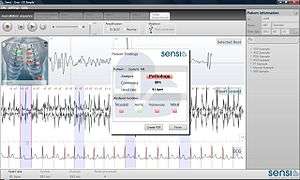Computer-aided auscultation
Computer-aided auscultation (CAA) is a clinical decision support system, which is designed to assist physicians and other health professionals with decision making tasks when assessing a heart murmur.[1] The need for computer-aided auscultation is increasing as the auscultation skills of physicians are declining. More than half of the number of babies with undiagnosed congenital heart defects, which comes to light in infancy, are missed by routine neonatal examination and more than one third by the 6 week examination.[2] In many cases the referral of paediatric patients to paediatric cardiologist are subjective and more than 60% of the referrals are due to an innocent or functional murmur.[3]
A computer-aided auscultation clinical decision support uses an electronic stethoscope to record the acoustic heart sound and acoustic signal processing algorithms; and a computer to analyze the recording to identify specific heart sounds that may be present, including S1, S2 and suspected murmurs. A graphic user interface displays the results.

Auscultation and heart defects
Heart defects are a major cause of worldwide morbidity and mortality. Properly performed, the cardiac auscultatory examination is an inexpensive, widely available tool in the detection and management of heart disease. Unfortunately, accurate interpretation of heart sounds by primary care providers is fraught with error, leading to missed diagnosis of disease and/or excessive costs associated with evaluation of normal variants. Thus, automated heart sound analysis, also known as computer aided auscultation (CAA), has the potential to become a cost-effective screening and diagnostic tool in the primary care setting.[5]
History of CAA
CAA started when heart sounds could be captured for analysis and further study. The digitizing of heart sounds using simple microphones where first captured on a tape recorder in the mid nineties. Studies focusing on CAA really only become popular when laptop computers and specialized digital stethoscopes started being used more commonly. The early 1990s and 2000 studies[6] focused on the use of frequency domain Fourier analysis of heart sounds. Whereas, newer Time–frequency analysis like, Wavelet and Wigner distribution function showed enhanced detail when investigating murmurs. Further classification techniques has evolved from the Decision tree methods to more complex methods such as Artificial neural network and Hidden Markov model.
Today, powerful personal computers are available and large medical manufactures are offering very good digital stethoscopes. Capturing heart sounds have become simple enough to become part of everyday auscultation use. Analyses of these recordings can be done quickly enough to act as an aid in diagnostic decision making.
Components in a CAA system
The main components in a CAA systems involves the hardware; computer and stethoscope, and a software solution for analysis.
Acquisition and storage
Data acquisition is done by capturing the input from the stethoscope and recording that data. The data is usually saved in a lossless WAV file format. Other formats where lossy compression techniques are used are not recommended such as MP3.
Analysis
Tools to analyse sound are widely used in the sound engineering field. To analyse heart sounds specialized software is however required. Heart sounds are a non-Stationary process making it difficult to use some Digital signal processing techniques. Background noises and noisy sounds made by the lungs and bowels can also affect the analysis. Some specialized software tools exist that can automatically detect S1-S2 components in a heart beat and even detect S3 and S4 sounds. The real value of a CAA system is when irregular heart sound and heart murmurs can be detected.
Classification
Detecting irregular heart sounds is only the beginning. Once these irregularities are detected they can be classified into groups. These classifications can be as simple as differentiating between physiological heart sounds and pathological heart sounds. More complex classification might be to specify the condition which caused the murmur.
See also
References
- ↑ Pretorius, Eugene; Thys Cronje; Otto Strydom (2010). "Development of a pediatric cardiac computer aided auscultation decision support system". Conference of the IEEE Engineering in Medicine and Biology Society. 2010: 6078–82. doi:10.1109/IEMBS.2010.5627633. PMID 21097128.
- ↑ Wren, Christopher; Sam Richmond; Liam Donaldson (1999). "Presentation of congenital heart disease in infancy: implications for routine examination". Arch Dis Child Fetal Neonatal Ed. 80: F49–F53. doi:10.1136/fn.80.1.f49.
- ↑ McCrindle, BW; Shaffer KM; Kan JS; Zahka KG; Rowe SA; Kidd L (1995). "Factors prompting referral for cardiology evaluation of heart murmurs in children". Archives of Paediatrics & Adolescent Medicine. 149 (11): 1277–1279. doi:10.1001/archpedi.1995.02170240095018. PMID 7581765.
- ↑ "Diacoustic Medical Devices".
- ↑ Mahnke, C (2009). "Automated heartsound analysis/computer-aided auscultation: A cardiologist's perspective and suggestions for future development.". Conf Proc IEEE Eng Med Biol Soc. 2009: 3115–3118.
- ↑ Cathers, Ian. "Neural network assisted cardiac auscultation". Retrieved 15 June 2011.